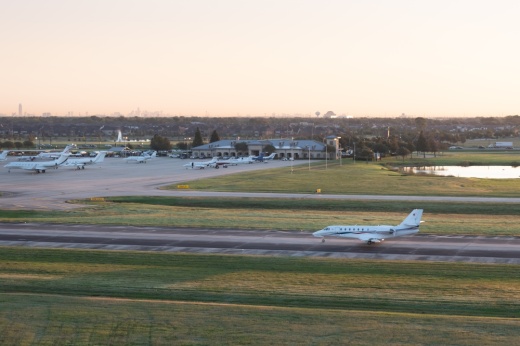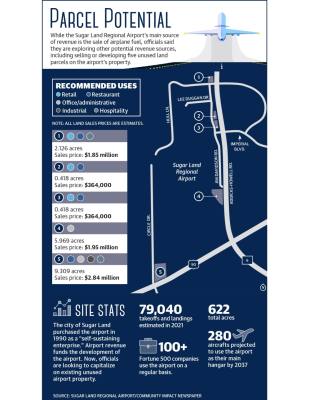Located at the intersection of Hwy. 90 and Hwy. 6, the Sugar Land Regional Airport serves primarily corporate entities while also acting as a reliever airport for George Bush Intercontinental Airport and Hobby Airport. While the airport’s primary source of revenue is the sale of fuel for planes using the facility, officials said they are exploring other potential revenue sources, such as selling or developing unused land on the airport’s property.
The airport’s 2019 master plan identified five airport-owned sites that could be used for nonaviation purposes. An ongoing assessment will determine what development options are legal, possible and allowed while resulting in the highest value, according to an Oct. 5 meeting of the Sugar Land Development Corporation and Sugar Land 4B Corporation boards.
Set to be released in mid-2022, the study will offer insight on how officials may want to develop the remaining land. Uses could include retail, restaurants, hospitality, light industrial use, and office and administrative use, said Elizabeth Rosenbaum, the director of aviation at the airport.
“At this point, they could be anything,” Rosenbaum said. “It is going to be an exciting process.”
Role of the airport
The Sugar Land Regional Airport was established in the 1950s after Donald “Doc” Hull—an oral surgeon who provided dental care to inmates located at the nearby Texas Department of Corrections, Southern Region—needed to shorten his commute to the prison, according to Sugar Land’s website.
The airport was owned by two different owners after Hill, including Fort Bend County, before the city of Sugar Land acquired it in 1990, according to the city’s website. Now, the airport provides 482 jobs to the area and is responsible for generating $264,500 every day on average in Fort Bend County, according to a February 2022 economic impact analysis.
The data from the analysis also concluded $8,600 is generated daily through local tax revenue via activity at the airport. In 2021, the airport served 13,500 aircrafts with an estimated 79,040 operations—or takeoffs and landings—according to Sugar Land’s fiscal year 2021-22 budget.
Sugar Land Communications Director Doug Adolph said the airport helps position Sugar Land as a regional business leader.
“Corporate business travelers utilize the airport to quickly access local markets,” Adolph said. “The close proximity to the Houston region has been an important decision for corporations considering relocations to Sugar Land.”
According to the city’s FY 2021-22 budget, airport services make up 4.6% of the city’s total expenditures at $11.68 million, and airport revenues in FY 2020-21 accounted for $15.6 million. Of that revenue, $11.9 million—or 6.3% of the city’s total revenue—came from fuel sales through Global Select, the organization proving aeronautical services to the airport.
“Global Select at Sugar Land Regional Airport is a corporate gateway to Houston, and its successes is helping fuel the regional economy,” Sugar Land Economic Development Director Elizabeth Huff said.
While the facility has long served as a source of revenue and out-of-town visitors, airport officials are looking to capitalize on some of its unused land located on the property. Five parcels totaling 18.24 acres are zoned for nonaviation uses.
Many projects in the airport’s 2019 master plan, including an ongoing taxiway relocation that will finish this year, are waiting on funding from various entities, such as the Texas Department of Transportation’s Aviation Division, which helps Texas cities and counties obtain and disburse funds for reliever and general aviation airports. However, the unused parcels will create another source of revenue for the airport.
“We want to move forward [with projects], but we can’t move forward until we figure out what the funding is,” Rosenbaum said, adding the airport is always seeking other grants.
Targeting growth
The city has collaborated with the airport on the potential use of the land. Devon Rodriguez, Sugar Land’s assistant director of economic development, said city staff hopes the site assessment, which began in 2021, will be completed in mid-2022. However, officials already have some insight into how the pieces of land could be used.
According to the October presentation, the northernmost tract is appropriate for hospitality or a free-standing retail use, such as a restaurant. The two tracts south of it are appropriate for fast-food restaurants or free-standing retail use, and the southeastern tract use will likely be oriented toward low-rise office or administration use. The westernmost plot should be for light industrial use due to access and noise issues based on the land’s location north of the Union Pacific Corp. railroad, per city documents.
Rodriguez said the site assessment will give more insight into the future of each piece of land.
“The site assessment will rank opportunity sites based on qualitative [and] objective observations and their alignment with target industry needs,” Rodriguez said.
An earlier phase of the study that took place in 2021 identified five target industry clusters: advanced manufacturing, life sciences, business and professional services, information and technology, and tourism. The clusters will build on existing industries to leverage aligned opportunities for employment growth and investment, city officials said.
“We don’t have a lot of land,” Rodriguez said. “We want to prioritize [land that we do have] for the specific target industries that we have.”






